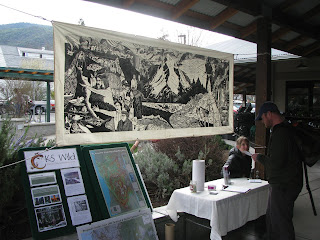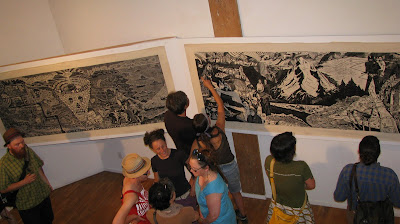Olivia Schmidt sent along some great photos of the prints from events that she's been coordinating to spread the word about opposition to LNG projects.
Field trip to the site of the now-defunct Bradwood Landing location, where LNG would have come ashore near the mouth of the Columbia.

Organizers and affected parties with Icky's No LNG poster. (That's Olivia, second from left)
Ted Messing, anti-LNG activist, ogles the banner at the Columbia Riverkeeper benefit auction.
Getting ready to raffle off the small silkscreened edition of the prints.
Here's what Olivia has to say about the variety of events where the prints have been on display in the past several months:
1) Banners were displayed at community meetings with Oregon Citizens Against the Pipelines in Yamhill and Forest Grove. At those meetings landowners impacted by the LNG-related pipeline projects viewed the banners laid out on tables at the end of our meetings, discussed the imagery and tried to identify familiar faces and landmarks in the Oregon piece.
2) Banners were displayed at a community meeting with Anti-LNG activists in Portland at the Portland LNG Working Group meeting. Also on tables after the meeting. At that meeting I laid them out with Indonesia on top and Oregon on bottom which creates a sort of hour glass image (with the conical elements in the center of the image) which one person pointed out has a sort of eerie "time is running out" message.
3) Smaller paper prints of Crisis were displayed at the Lower Columbia 3 meeting in Cathlamet, WA where communities impacted by proposed LNG import terminal development on the Columbia River viewed the prints during our pre-meeting potluck. Vonda Brock is a member of that group and identified with the woman in the fore of the image with a hat and braids (which looks a lot like her). It was totally sweet to see members of that particular community relate so closely with the piece.
4) Banners were displayed at a presentation of LNG:101 (my basic power point) at the Concordia University where 40 attendees heard an LNG info talk, viewed a short documentary about the pipelines and viewed the banners laid out at the front of the room at the end of the lecture. It was really effective to have multi-media methods of communicating about this issue to the audience. Most of the attendees walked to the front of the room to really look at the prints up close.
5) Banners were displayed at the Sierra Club Strategic Planning Retreat near Colton, OR where 30 of Oregon Chapter Sierra Club's core volunteers from across Oregon viewed the images during breaks from our meeting. It was a really effective and subtle way to generate questions and conversation about LNG from attendees without trying to insert that topic into the agenda of our 3-day meeting.
6) 20 people participated in field trip to the proposed site of Oregon LNG's import terminal in Warrenton, OR and viewed the banners as a closing to the day spent on the actual land where Oregon LNG wants to develop. Attendees came from Clatsop, Tillamook and Multnomah Counties in Oregon, and Cowlitz and Wahkiakum Counties in Washington. Attendees included LNG impacted communities as well as Anti-LNG activists not directly impacted by LNG proposals. (you've got pics of this one)
7) Banners displayed at Columbia Riverkeeper auction in PDX with 200 attendees who all viewed the Oregon banner in the hallway and the smaller prints (both Indo. and Or.) in the main silent auction room. Mostly folks from PDX but also some LNG impacted supporters of Columbia Riverkeeper.


 Here are some fantastic pictures that Ucup sent along from Indonesia: they feature the two prints, wonderfully stitched together, at the site of the Sidoarjo mud-flow, an environmental and social disaster area in North Java. The desolate area in the background is the result of a blowout of a natural-gas well. Hot volcanic mud has been pouring from the site of the well for years, inundating local villages and fields and displacing thousands. These photos were taken during a recent solidarity campaign organized by Taring Padi artists and activists.
Here are some fantastic pictures that Ucup sent along from Indonesia: they feature the two prints, wonderfully stitched together, at the site of the Sidoarjo mud-flow, an environmental and social disaster area in North Java. The desolate area in the background is the result of a blowout of a natural-gas well. Hot volcanic mud has been pouring from the site of the well for years, inundating local villages and fields and displacing thousands. These photos were taken during a recent solidarity campaign organized by Taring Padi artists and activists.


































